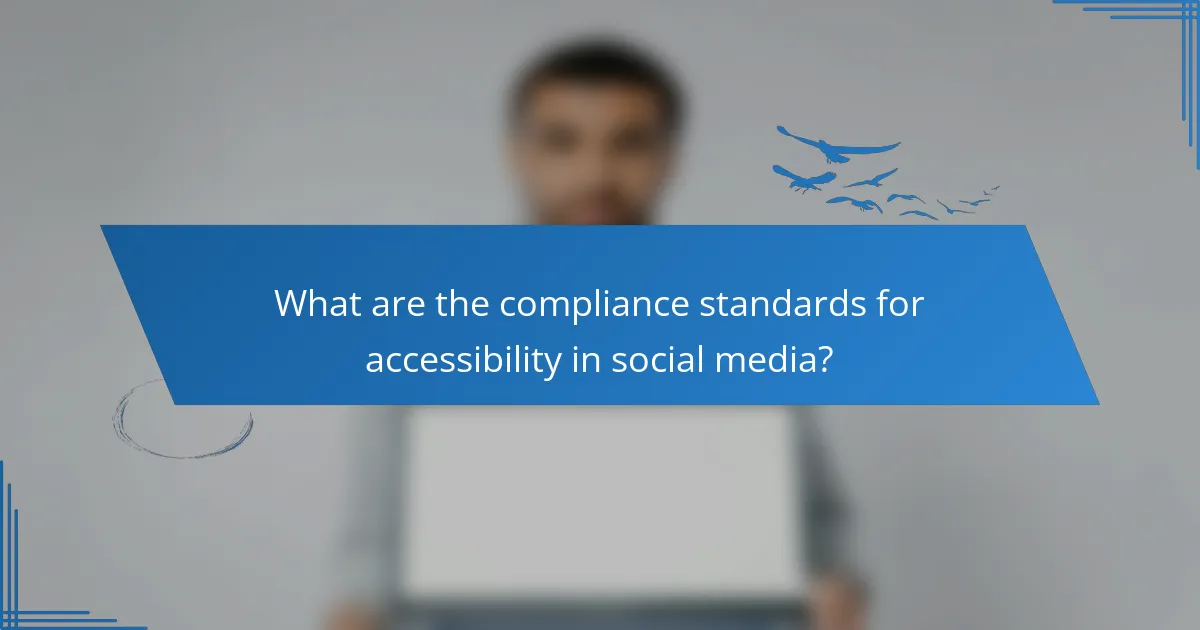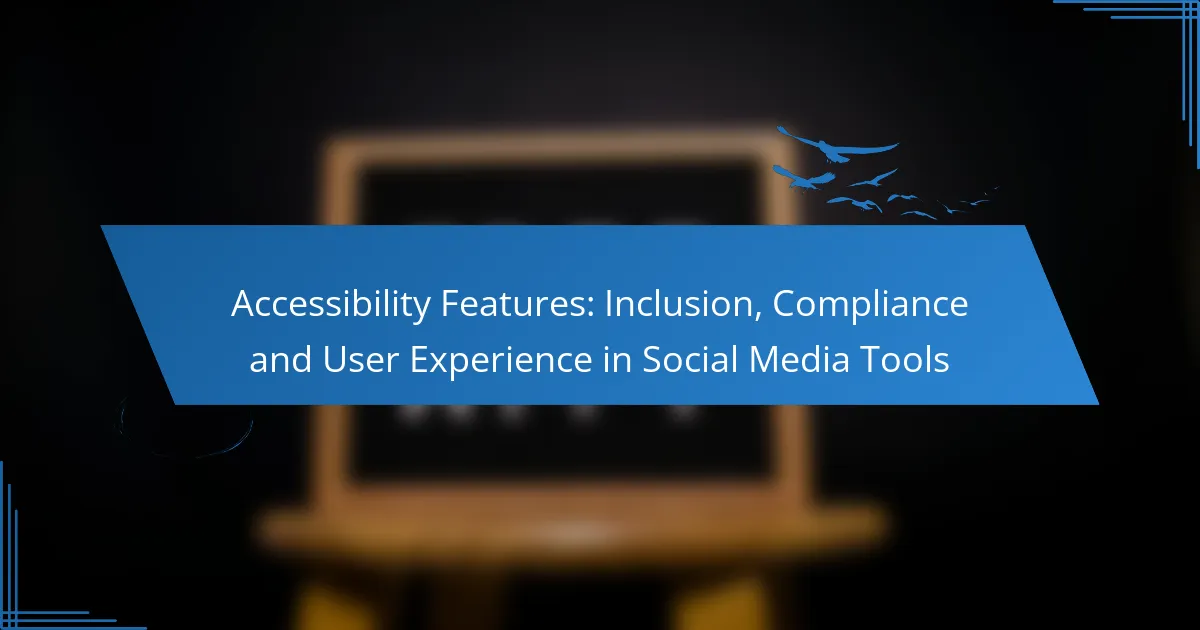Accessibility features in social media tools play a crucial role in enhancing the user experience for individuals with disabilities. By ensuring compliance with accessibility standards, these features promote inclusion and allow all users to navigate and engage with content effectively, fostering a more equitable online environment.

What are the key accessibility features in social media tools?
Key accessibility features in social media tools enhance user experience for individuals with disabilities. These features ensure that all users can navigate, interact, and consume content effectively, promoting inclusion and compliance with accessibility standards.
Screen reader compatibility
Screen reader compatibility allows visually impaired users to access content through audio output. Social media platforms should ensure that all text elements, including posts, comments, and buttons, are properly labeled for screen readers to interpret.
To improve compatibility, developers should follow the Web Content Accessibility Guidelines (WCAG) and regularly test their platforms with various screen readers. Common pitfalls include using images without text alternatives or improperly structured headings.
Keyboard navigation support
Keyboard navigation support enables users to navigate social media platforms without a mouse, which is crucial for individuals with mobility impairments. Effective keyboard navigation includes logical tab orders and the ability to activate buttons and links using keyboard shortcuts.
To enhance this feature, ensure that all interactive elements are reachable via the keyboard and provide clear visual focus indicators. Avoid using keyboard traps that prevent users from exiting interactive elements.
Alternative text for images
Alternative text (alt text) for images provides a textual description of visual content, allowing screen reader users to understand the context. Each image should have descriptive alt text that conveys the essential information or function of the image.
When writing alt text, be concise yet informative, focusing on what is necessary for understanding. Avoid phrases like “image of” or “picture of,” as they add no value to the description.
Captioning for videos
Captioning for videos ensures that users who are deaf or hard of hearing can access audio content through text. Captions should accurately reflect spoken dialogue, sound effects, and relevant non-verbal cues to provide a complete understanding of the video.
Platforms should offer options for both automatic and manual captioning, allowing content creators to edit captions for accuracy. It’s essential to ensure captions are synchronized with the audio for optimal user experience.
Color contrast settings
Color contrast settings help users with visual impairments distinguish between text and background colors. High contrast ratios improve readability and are essential for users with color blindness or low vision.
To meet accessibility standards, aim for a contrast ratio of at least 4.5:1 for normal text and 3:1 for large text. Provide users with options to customize color settings or switch to high-contrast modes to enhance visibility.

How do accessibility features enhance user experience?
Accessibility features significantly improve user experience by ensuring that social media tools are usable by everyone, including those with disabilities. These features create an inclusive environment that fosters better interaction, engagement, and satisfaction across diverse user groups.
Improved engagement for all users
Accessibility features encourage broader participation by making content more engaging for all users. For instance, captions and transcripts for videos not only assist those with hearing impairments but also benefit users in noisy environments or those who prefer reading. This inclusivity can lead to increased interaction rates and a more vibrant online community.
Social media platforms that prioritize accessibility often see higher user retention. When users feel that their needs are met, they are more likely to engage consistently with the platform, share content, and contribute to discussions.
Increased content discoverability
Accessibility features enhance content discoverability by making it easier for users to find and engage with posts. Alt text for images, for example, allows search engines to index content more effectively, improving visibility in search results. This can lead to a broader audience reach and greater organic traffic.
Additionally, using clear and descriptive headings and tags can help users navigate content more efficiently. Implementing these practices can boost the likelihood of content being shared, further expanding its reach.
Enhanced usability for disabled users
Accessibility features are crucial for enhancing usability for disabled users, ensuring they can navigate social media tools effectively. Features like screen reader compatibility, keyboard navigation, and customizable text sizes allow users with visual impairments to access content seamlessly.
It’s essential for social media platforms to adhere to established guidelines, such as the Web Content Accessibility Guidelines (WCAG), to ensure compliance and improve user experience. Regular testing with assistive technologies can help identify areas for improvement, ensuring that all users can participate fully in the online community.

What are the compliance standards for accessibility in social media?
Compliance standards for accessibility in social media ensure that platforms are usable by individuals with disabilities. These standards include guidelines and regulations that promote inclusivity and equal access to information and services.
WCAG 2.1 guidelines
The Web Content Accessibility Guidelines (WCAG) 2.1 provide a framework for making web content more accessible. These guidelines focus on four principles: perceivable, operable, understandable, and robust, which help ensure that all users can interact with social media tools effectively.
To comply with WCAG 2.1, social media platforms should implement features such as text alternatives for non-text content, keyboard navigability, and sufficient contrast between text and background colors. Regular audits and user testing can help identify areas for improvement.
ADA compliance requirements
The Americans with Disabilities Act (ADA) mandates that public accommodations, including online platforms, must be accessible to individuals with disabilities. This includes ensuring that social media tools do not exclude users based on their disabilities.
To meet ADA compliance, social media companies should provide accessible design features, such as screen reader compatibility and captioning for videos. Failure to comply can lead to legal challenges and reputational damage.
UK Equality Act 2010 implications
The UK Equality Act 2010 requires that services, including social media, are accessible to all users, regardless of disability. This law emphasizes the need for reasonable adjustments to be made to ensure equal access.
Social media platforms operating in the UK should consider implementing features like adjustable text sizes and alternative text for images. Regular training for developers on accessibility best practices can help maintain compliance with the Equality Act.

Which social media platforms excel in accessibility?
Several social media platforms have made significant strides in accessibility, ensuring that users with disabilities can engage fully. Facebook, Twitter, and Instagram are notable for their innovative features designed to enhance user experience for all individuals.
Facebook’s accessibility tools
Facebook offers a range of accessibility tools that cater to users with various needs. Features include screen reader compatibility, customizable text size, and color contrast adjustments, allowing users to tailor their experience for better readability.
Additionally, Facebook provides automatic alt text for images, which uses AI to describe photos for visually impaired users. This feature enhances inclusivity by ensuring that all users can understand the content being shared.
Twitter’s alt text feature
Twitter allows users to add alt text to images, making it easier for visually impaired individuals to comprehend visual content. When uploading an image, users can include a brief description that conveys the essential elements of the picture.
To utilize this feature effectively, users should aim for concise yet descriptive text, ideally under 100 characters. This ensures that the alt text is informative without being overwhelming, enhancing the overall accessibility of tweets.
Instagram’s captioning options
Instagram has introduced automatic captioning for videos, which is a crucial feature for users who are deaf or hard of hearing. This functionality generates captions in real-time, allowing users to follow along with video content without missing important dialogue.
Content creators are encouraged to add captions manually for static posts or stories to ensure accessibility. By including clear, readable captions, they can improve engagement and inclusivity for all followers.

What are the challenges in implementing accessibility features?
Implementing accessibility features in social media tools faces several challenges, including a lack of awareness, insufficient resources, and the need to balance design with functionality. These obstacles can hinder the development of inclusive platforms that cater to all users.
Lack of awareness among developers
Many developers are not fully aware of the importance of accessibility features, which can lead to oversight during the design and development phases. This lack of awareness can stem from insufficient training or exposure to accessibility standards, resulting in tools that do not meet the needs of users with disabilities.
To combat this, organizations should invest in training programs that educate developers about accessibility guidelines, such as the Web Content Accessibility Guidelines (WCAG). Regular workshops and resources can help foster a culture of inclusivity within development teams.
Resource allocation for accessibility
Allocating resources for accessibility can be challenging, especially in organizations with tight budgets. Often, accessibility is viewed as an additional cost rather than a necessary investment, leading to inadequate funding for the development of accessible features.
To improve resource allocation, companies should prioritize accessibility in their project planning and budgeting processes. This can include setting aside specific funds for accessibility initiatives and integrating accessibility goals into overall project objectives.
Balancing design aesthetics with functionality
Designing visually appealing social media tools while ensuring they are functional for all users can be a delicate balance. Developers often face pressure to create trendy designs that may not consider accessibility, leading to features that are difficult for some users to navigate.
To strike this balance, teams should adopt a user-centered design approach that includes testing with diverse user groups. Incorporating feedback from users with disabilities can help ensure that aesthetic choices do not compromise accessibility, ultimately leading to a more inclusive user experience.

How can businesses improve accessibility in their social media strategies?
Businesses can enhance accessibility in their social media strategies by implementing inclusive design practices and adhering to established guidelines. This ensures that all users, including those with disabilities, can engage with content effectively and enjoyably.
Conducting accessibility audits
Conducting accessibility audits involves evaluating social media platforms and content to identify barriers that may hinder users with disabilities. This process typically includes reviewing visual elements, text readability, and navigational ease.
To perform an effective audit, businesses should utilize tools such as automated accessibility checkers and manual testing with diverse user groups. Common issues to look for include missing alt text for images, insufficient color contrast, and non-descriptive link text.
Regular audits can help maintain compliance with accessibility standards like the Web Content Accessibility Guidelines (WCAG). Aim to conduct these audits at least annually or whenever significant changes are made to social media strategies or platforms.
